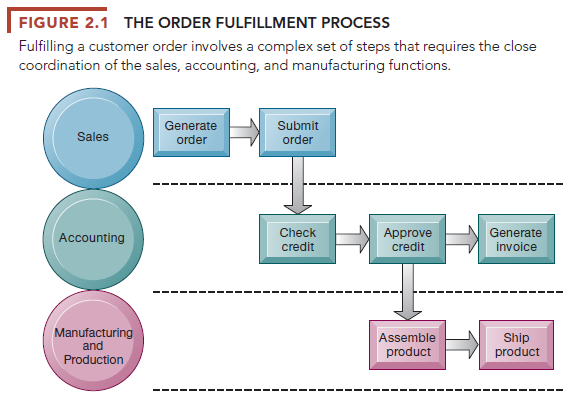Business processes, which we introduced in Chapter 1, refer to the manner in which work is organized, coordinated, and focused to produce a valuable product or service. Business processes are the collection of activities required to produce a product or service. These activities are supported by flows of material, information, and knowledge among the participants in business processes. Business processes also refer to the unique ways in which organizations coordinate work, information, and knowledge, and the ways in which management chooses to coordinate work.
To a large extent, the performance of a business firm depends on how well its business processes are designed and coordinated. A company’s business processes can be a source of competitive strength if they enable the company to innovate or to execute better than its rivals. Business processes can also be liabilities if they are based on inefficient ways of working that impede organizational responsiveness and efficiency. The chapter-opening case describing Sanofi Pasteur’s improvements in knowledge-sharing processes clearly illustrates these points, as do many of the other cases in this text.

Every business can be seen as a collection of business processes, some of which are part of larger encompassing processes. For instance, uses of mentoring, wikis, blogs, and videos are all part of the overall knowledge management process. Many business processes are tied to a specific functional area. For example, the sales and marketing function is responsible for identifying customers, and the human resources function is responsible for hiring employees. Table 2.1 describes some typical business processes for each of the functional areas of business.
Other business processes cross many different functional areas and require coordination across departments. For instance, consider the seemingly simple business process of fulfilling a customer order (see Figure 2.1). Initially, the sales department receives a sales order. The order passes first to accounting to ensure the customer can pay for the order either by a credit verification or request for immediate payment prior to shipping. Once the customer credit is established, the production department pulls the product from inventory or produces the product. Then the product is shipped (and this may require working with a logistics firm, such as UPS or FedEx). A bill or invoice is generated by the accounting department, and a notice is sent to the customer indicating that the product has shipped. The sales department is notified of the shipment and prepares to support the customer by answering calls or fulfilling warranty claims.

What at first appears to be a simple process, fulfilling an order, turns out to be a very complicated series of business processes that require the close coordination of major functional groups in a firm. Moreover, to efficiently perform all these steps in the order fulfillment process requires a great deal of information. The required information must flow rapidly within the firm from one decision maker to another; with business partners, such as delivery firms; and with the customer. Computer-based information systems make this possible.
Source: Laudon Kenneth C., Laudon Jane Price (2020), Management Information Systems: Managing the Digital Firm, Pearson; 16th edition.

Hurrah, that’s what I was exploring for, what a material!
existing here at this web site, thanks admin of this web site.